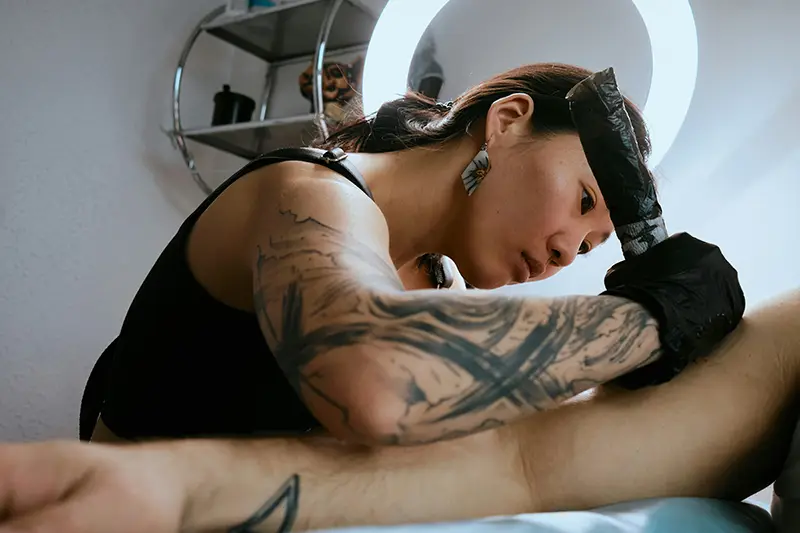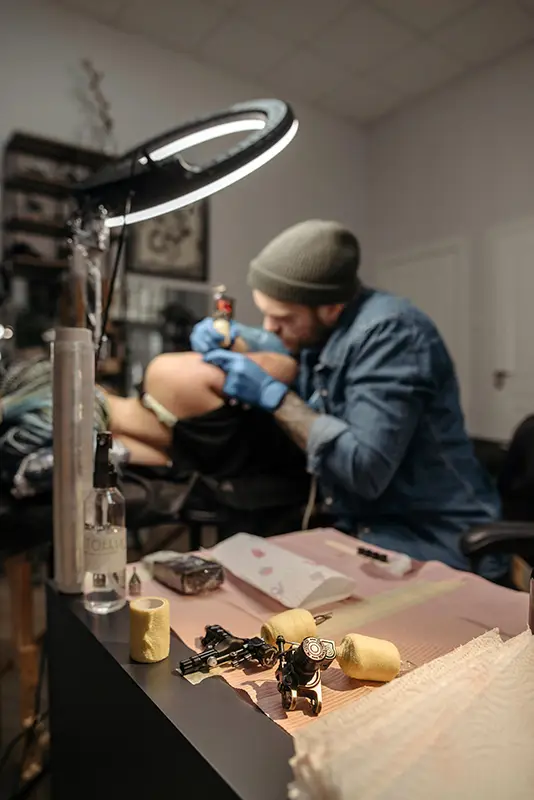
Blog post -
How tattoo ink travels in body & its changes with age
An individual may have regrets about their ink for many reasons and so may want to seek removal treatments. To understand how it works, particularly laser tattoo removal, one must first understand how a tattoo is rendered.
How deeply does the tattoo get into your skin?
While tattooing is an ancient practice that first used sharp wooden sticks to deposit ink into the skin, today's tattooing technique primarily revolves around using a tattoo gun.
The tattoo needle punctures skin around 100 times per second, depositing the ink 1.5mm to 2mm below the skin surface [1]. This enables the ink to bypass the epidermis.
What happens to the tattoo ink after it's injected into your skin?

For the ink to remain permanent, it must be delivered into the dermis layer, where the body's immune function keeps the ink in place forever. This is where the nerves and blood vessels are located, which explains why skin tends to bleed while getting a tattoo done. The bleeding is part of the skin's natural defence against injury.
Recent research has shown that the body continues to respond to being tattooed [2]. Not only does it produce white cells in large numbers, but it also continues to protect itself by sending immune cells, which is why the ink stays in place.
Fresh ink will experience some pigment loss, but most ink will stay – 68% of ink was still present at the injection site 42 days after the tattoo was done [3].
Does tattoo ink travel through your body?

While most of the ink stays in place, some pigments can traverse the body to the lymph nodes and other parts as well. Scientists discovered that nanoparticles, measuring less than 100 nanometers across, were most likely to have relocated to the lymph nodes [4].
In a 2015 report published in the Obstetrics and Gynaecology journal, doctors described how, at first, they found a woman's cervical cancer had spread, particularly to her lymph nodes. On successfully removing the nodes, they discovered that what they thought were malignant cells were, in actual fact, tattoo ink particles [5].
What is tattoo ink actually made of?

A common ingredient in tattoo inks, carbon black, appears to break down quickly into nanoparticles, ending up in the lymph nodes.
Some larger particles of another common ingredient used in white pigments are Titanium Dioxide (TiO2). Other matters found include nickel, cobalt and chromium, which are sometimes added to tattoo pigment as preservatives.
What happens to your tattoo as you get older? Other factors that affect a tattoo's appearance
Inevitably, tattoos fade over time. This process starts almost immediately after a tattoo session as your skin heals. As time passes, the colours will look less vibrant.
In some cases, the pigments may break down, causing the design to resemble the original less and resulting in a muddled appearance.
Other factors that affect a tattoo's appearance include:
1. Sunlight
The most common cause is sun exposure. The sun's UV rays, as we know, can cause a myriad of skin issues as they can penetrate deep into the skin. Although the dermis layer is generally safe from its burning effect, the ink will start to break down over time and become noticeably less effective.
This process is at its peak when the tattoo is healing, as the skin is most sensitive and vulnerable. The use of sun protection cream and lotion is essential for a tattoo to maintain its colours and vibrancy for the long term.
2. Poor aftercare routine
Aftercare is essential after getting inked. In fact, proper care is necessary for almost everything we acquire to maximise its quality of life. A beautifully inked piece of work needs care and attention as it is part of your skin, after all. Failing to heed advice on the matter or being ignorant of it can be the difference between money well-spent and a lifetime's regret.
3. Bad quality ink
Quality begets quality, so don't be a scrooge and opt for ink just because it's cheap - chances are the quality of the ink used is suspect. Cheap ink, including DIY ones [6], can compromise the skin, causing issues that may not be reversible and are detrimental to health.
4. Tattoo ink colour
Colour choice also plays a vital role in the lifespan of an ink. Blackwork tattoos and grayscale colours generally last longer compared to coloured ones. With that said, however, it also depends on the experience of the tattooist.
Watercolour tattoos look absolutely stunning, but the chances of them fading quickly are also high, which is a reminder that just because something looks great on paper, it doesn't mean it will continue looking as such on skin. This is best discussed with your tattoo artist.
5. Tattoo placement
Not many people realise that a tattoo's placement can significantly contribute to or restrict its lifespan. Areas exposed to light (and sunlight) run the risk of fading fast.
So get tattoos on areas where friction and wear are regularly applied. This is because skin cells are lost more easily in those areas, causing the ink to fade. If you're concerned about distortion, it's best to avoid areas prone to weight gain.
6. Tattoo design detail
The more intricate and detailed a tattoo is, the higher the risk of fading. Small inks with equally tiny lettering and lines tend to fade quickly than those with bolder lines. These types of tattoos are challenging for both the tattooist and the skin.
7. Lifestyle
Generally, taking care of skin involves several factors, including leading a healthy lifestyle. Ensure your body gets the proper rest and hydration it needs, protection from harmful elements like the sun's UV rays, and moderation in habits like smoking and indulgences like alcohol. All these pave the way for better skin and help preserve the lifespan of your tattoo.
8. The tattoo artist
Arguably, the most crucial factor when getting a tattoo is the tattoo artist. The artist's experience, proficiency level, and ability to envision the ink's actual outcome are just some things to consider.
Never choose someone just because they're cheap, and don't rely solely on word of mouth. Do proper research because this concerns your skin and, to an extent, your well-being.
Also, remember that tattoos come in an assortment of techniques and designs, so an artist who excels in blackwork may not be as proficient in multicoloured ones.
Do tattoos look bad when you get older?
Tattoos do fade as we age. The best we can do is ensure that we get one that can at least hold its shape and maintain its design. Sagging and wrinkling of skin with ageing is expected, so it's best to plan a tattoo where such effects will not be so pronounced.
Can tattoos age well?
Skin, with proper care that includes a healthy lifestyle, can do wonders when it comes to minimising the effects of ageing.
Tattoos that are well taken care of (beyond the "honeymoon" period) can result in a longer lifespan in their vibrancy and appearance. A tattoo is a lifetime commitment, so having the discipline to maintain it is a prerequisite.
What to do if you no longer like your tattoos?
When it comes to tattoos, aside from cover-up recourse, there's also complete tattoo removal via laser treatment.
Picolaser Tattoo Removal involves using a laser specially designed to remove ink on the skin without affecting surrounding areas.